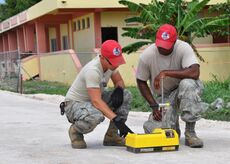Physics:Nuclear density gauge
| It has been suggested that Nuclear densometer be merged into this page. (Discuss) Proposed since November 2019. |

A nuclear density gauge is a tool used in civil construction and the petroleum industry, as well as for mining and archaeology purposes. It consists of a radiation source that emits a cloud of particles and a sensor that counts the received particles that are either reflected by the test material or pass through it. By calculating the percentage of particles that return to the sensor, the gauge can be calibrated to measure the density and inner structure of the test material.
Background
Different variants are used for different purposes. For density analysis of very shallow objects such as roads or walls, a gamma source emitter such as 137Cesium is used to produce gamma radiation. These isotopes are effective in analyzing the top 10 inches (25 centimeters) with high accuracy. 226Radium is used for depths of 328 yards (300 meters). Such instruments can help find caves or identify locations with lower density that would make tunnel construction hazardous.
Nuclear density gauges can also be used to measure the density of a liquid in a pipe. If a source is mounted on one side of a pipe and a detector on the other, the amount of radiation seen at the detector is dependent upon the shielding provided by the liquid in the pipe. Tracerco pioneered the use of radiation to measure density in the 1950s and determined that the Beer–Lambert law also applied to radiation as well as optics. Gauges are normally calibrated using gas and a liquid of known density to find the unknowns in the equation. Once it has been calibrated and as long as the source detector alignment remains constant, it is possible to calculate the density of the liquid in the pipe. One factor is the half life of the radioactive source (30 years for 137Cs), which means that the system needs to be recalibrated at regular intervals. Modern systems incorporate correction for source decay.[1]
Another variant is to use a strong neutron source like 241Americium/Beryllium to produce Neutron radiation and then measure the energy of returning neutron scattering. As hydrogen characteristically slows down neutrons, the sensor can calculate the density of hydrogen - and find pockets of underground water, humidity up to a depth of several meters, moisture content, or asphalt content. Neutron sources can also be used to assess the performance of a Separator (oil production) in the same way. Gas, oil, water and sand all have different concentrations of hydrogen atoms which reflect different amounts of slow neutrons. Using a head which contains an 241AmBe neutron source and a slow neutron detector, by scanning it up and down a separator it is possible to determine the interface levels within the separator.
Nuclear density gauges are typically operated in one of two modes:[2]
Direct transmission: The retractable rod is lowered into the mat through a pre-drilled hole. The source emits radiation, which then interact with electrons in the material and lose energy and/or are redirected (scattered). Radiation that loses sufficient energy or is scattered away from the detector is not counted. The denser the material, the higher the probability of interaction and the lower the detector count. Therefore, the detector count is inversely proportional to material density. A calibration factor is used to relate the count to the actual density.
Backscatter: The retractable rod is lowered so that it is even with the detector but still within the instrument. The source emits radiation, which then interact with electrons in the material and lose energy and/or are redirected (scattered). Radiation that is scattered towards the detector is counted. The denser the material, the higher the probability that radiation will be redirected towards the detector. Therefore, the detector count is proportional to the density. A calibration factor is used to correlate the count to the actual density.
Many devices are built to measure both the density and moisture content of material. This is important to the Civil construction industry specifically as both are essential to verifying suitable soil conditions to support structures, streets, highways, and airport runways.
References
- ↑ Jackson, Peter (2004). Radioisotope Gauges for Industrial. Chichester: John Wiley & Sons Ltd. doi:10.1002/0470021098.fmatter. ISBN 0-471-48999-9.
- ↑ M. Falahati (2018). "Design, modelling and construction of a continuous nuclear gauge for measuring the fluid levels". Journal of Instrumentation 13 (2): P02028. doi:10.1088/1748-0221/13/02/P02028.

